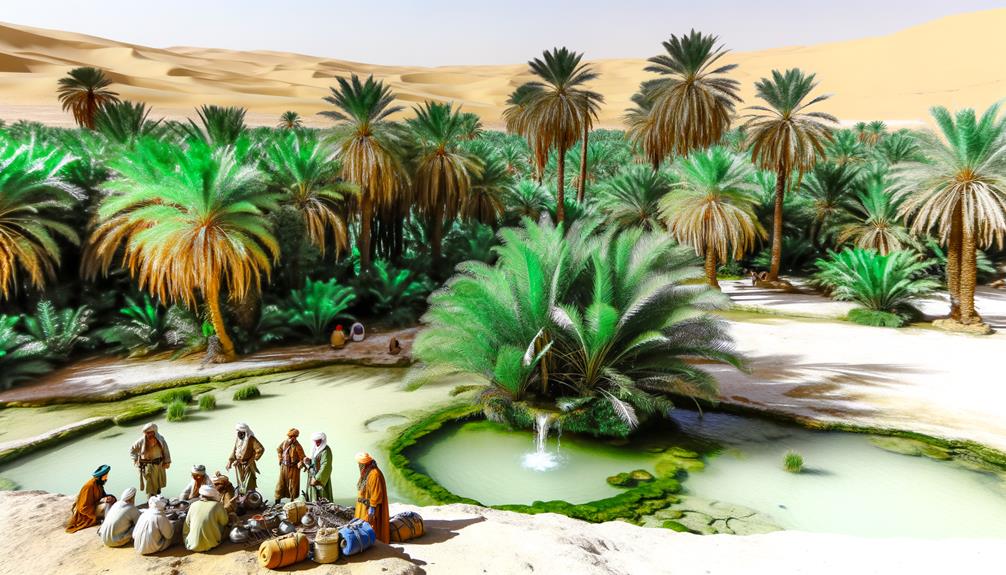Elim Meaning in the Bible: Rest and Refreshment
Elim, as noted in the Book of Exodus, is a critical waypoint for the Israelites during their escape from Egypt, marked by twelve springs of water and seventy palm trees. This oasis symbolizes divine sustenance and provision, contrasting sharply with the surrounding desert’s desolation.
The numbers twelve and seventy are significant, echoing the twelve tribes of Israel and the seventy elders, indicating completeness and divine order. Elim‘s depiction provides a theological metaphor for God’s care, embodying physical and spiritual nourishment.
To understand the profound implications of this biblical site, explore how it embodies divine grace and covenantal faithfulness.

Elim Meaning in the Bible: A Place of Rest, Refreshment, and Divine Provision
| Aspect | Biblical Interpretation | Key Verses |
|---|---|---|
| Definition | Elim means “trees” or “palms” | Exodus 15:27 |
| Physical Description | Oasis with 12 springs and 70 palm trees | Exodus 15:27 |
| Symbol of Rest | Represents peace and rest after hardship | Exodus 15:22–27 |
| Divine Provision | Reflects God’s care and provision in the wilderness | Numbers 33:9 |
| Spiritual Insight | Temporary blessing and encouragement on the journey of faith | Psalm 23:2, Isaiah 40:29–31 |
Elim in Biblical Context

Elim, mentioned in the Book of Exodus, serves as a significant waypoint for the Israelites during their exodus from Egypt, offering a place of respite with its twelve springs of water and seventy palm trees. This location is essential, symbolizing divine providence and sustenance amid the arduous desert journey.
Historically, Elim represents more than a mere physical oasis; it embodies a theological metaphor for God’s provision and care. The twelve springs and seventy palms are often interpreted as symbols of completeness and perfection, reflecting the twelve tribes of Israel and the seventy elders.
Theologically, Elim underscores the idea that divine guidance accompanies the faithful, providing not just physical relief but also spiritual reassurance during times of hardship.
Journey to Elim

As the Israelites traversed the harsh landscapes of the Sinai Peninsula, their journey to Elim marked a critical juncture where divine intervention manifested through the provision of essential resources.
Historically situated after their exodus from Egypt, this trek was fraught with physical and spiritual trials.
Theologically, Elim represented a sanctuary where God’s providence was vividly demonstrated. This oasis, characterized by its abundant water and shade, contrasted starkly with the preceding desolation of the wilderness.
The Israelites’ arrival at Elim, as recorded in Exodus 15:27, underscored a moment of relief and sustenance. Such instances of divine care reinforced their faith, shaping the collective memory and spirituality of a nascent nation learning to trust in God’s guidance.
Significance of Twelve Springs

The twelve springs at Elim, as documented in Exodus 15:27, symbolize not only physical nourishment but also hold profound theological significance, representing completeness and divine provision in biblical numerology. The number twelve frequently appears in Scripture, often associated with God’s governance and order.
- Tribal Representation: The twelve springs correlate with the twelve tribes of Israel, signifying provision for each tribe.
- Divine Order: Reflects the structured nature of God’s creation and His providence.
- Covenantal Promise: Reinforces God’s promise to sustain His people during their journey.
This multifaceted symbolism underscores Elim’s importance in the broader narrative of Israel’s desert sojourn.
Symbolism of Seventy Palms

The seventy palms at Elim carry profound biblical significance, symbolizing completeness and divine provision, echoing the seventy elders of Israel and the seventy disciples sent by Jesus.
This number’s recurrence in Scripture invites a deeper spiritual interpretation, suggesting themes of leadership, sustenance, and God’s covenantal faithfulness.
A historical context analysis reveals that these palms provided not only physical nourishment in the desert but also a powerful reminder of God’s sustaining grace amidst adversity.
Biblical Significance Explored
Nestled within the rich tapestry of biblical narrative, the seventy palms at Elim symbolically represent divine abundance and completeness, reflecting the providential care bestowed upon the Israelites during their desert sojourn. The number seventy frequently appears in Scripture, often signifying wholeness and perfection.
These palms at Elim highlight:
- Divine Provision: Representing God’s provision in a barren desert.
- Historical Significance: Echoing the seventy elders of Israel and the seventy nations listed in Genesis.
- Theological Insight: Emphasizing God’s holistic care for both physical and spiritual needs.
This site underscores God’s unwavering faithfulness, offering a sanctuary of sustenance and reassurance to His people.
Spiritual Interpretation Unveiled
In theological discourse, the seventy palms at Elim are often interpreted as a profound symbol of divine completeness and sustenance, deeply rooted in the spiritual heritage of the Israelites. The number seventy frequently symbolizes fullness or universality in biblical tradition, reflecting the encompassing nature of God’s provision. This symbolism is evident in various theological contexts:
| Element | Significance |
|---|---|
| Seventy Palms | Completeness and divine sustenance |
| Twelve Springs | The twelve tribes of Israel |
| Elim | A place of rest and rejuvenation |
| Biblical Seventy | Nations (Genesis 10), Elders (Numbers 11) |
| Spiritual Meaning | Divine provision and holistic care |
The seventy palms at Elim consequently underscore God’s holistic provision, reinforcing the spiritual narrative of reliance and trust in divine sustenance.
Historical Context Analysis
Rooted in the ancient traditions of the Israelites, the seventy palms at Elim serve as a compelling symbol of divine completeness and sustenance within the historical narrative of their wilderness journey.
This number, often associated with perfection and totality in biblical literature, underscores the providence and nurturing care of God during their exodus from Egypt. The seventy palms also mirror the seventy elders of Israel, reflecting a structured, divinely ordained community.
Divine Completeness: The number seventy signifies wholeness and spiritual perfection.
Provision: The palms and accompanying twelve springs offered physical and spiritual sustenance.
Leadership Symbolism: Parallels with the seventy elders suggest organized, divine governance.
Historical Relevance: This oasis provided a tangible respite, reinforcing faith amid the harsh desert environment.
This intricate symbolism enriches our understanding of Elim’s place in biblical history.
Elim’s Theological Implications

Elim’s theological implications are multifaceted, encompassing its role as an oasis of rest, a symbol of divine provision, and a site of profound spiritual significance.
Historically, Elim offered the Israelites respite and sustenance during their arduous desert journey, epitomizing God’s tangible care and sustenance.
Theologically, Elim embodies the concept of divine grace and provision, serving as a reminder of God’s unwavering support and the spiritual renewal available to the faithful.
Oasis of Rest
As an oasis of rest, Elim symbolizes divine provision and respite in the theological narrative of the Israelites’ journey through the wilderness. This location, characterized by its twelve springs and seventy palm trees, offers profound theological insights into God’s care and guidance.
Elim is not merely a physical place but a spiritual metaphor for renewal and hope amidst trials. It represents a divine intervention where God provides a sanctuary for His people, ensuring their well-being during arduous times.
Historical Significance: Elim marks a pivotal point in Israel’s exodus, illustrating God’s tangible support.
Spiritual Renewal: The oasis serves as a metaphor for spiritual rejuvenation.
Symbolic Numbers: Twelve springs and seventy palms hold symbolic meaning in biblical numerology.
Theological Implications: Elim underscores God’s unceasing provision and mercy.
Symbol of Provision
In the context of Israel’s wilderness journey, Elim stands as a profound witness to God’s unwavering provision and sustenance for His people.
Biblically, Elim is described as a sanctuary comprising twelve springs and seventy palm trees (Exodus 15:27). This oasis, encountered shortly after the bitter waters of Marah, symbolizes divine providence and relief amidst trials.
Historically, the springs and palm trees represent both physical nourishment and spiritual rejuvenation.
Theologically, Elim underscores the narrative of God’s faithfulness, illustrating how He meets the needs of His chosen ones in desolate circumstances.
This provision is not merely survival but an abundant blessing, reinforcing the covenantal promises and assuring Israel of God’s constant care during their arduous desert sojourn.
Spiritual Significance Unveiled
The theological implications of Elim, with its twelve springs and seventy palm trees, reveal profound insights into the nature of divine provision and the covenantal relationship between God and Israel.
Elim serves as a symbol of God’s abundant grace, offering respite to the Israelites during their arduous journey through the wilderness. This oasis underscores several key theological themes:
- Divine Faithfulness: Demonstrates God’s unwavering commitment to sustain His people.
- Covenantal Assurance: Reflects the ongoing fulfillment of God’s promises to Israel.
- Numerological Symbolism: The numbers twelve and seventy signify completeness and divine order.
- Provision and Rest: Elim represents a place of physical and spiritual replenishment amid trials.
These elements collectively deepen our understanding of God’s providence and fidelity in biblical narrative.
Lessons From Elim

Nestled in the narrative of the Israelites’ exodus from Egypt, Elim serves as a crucial waypoint that offers profound theological insights and practical lessons for faith and perseverance.
Encountering Elim’s twelve springs and seventy palm trees, the Israelites experienced a divine provision that contrasted with their prior hardships at Marah. This oasis symbolizes God’s timely intervention and sustenance in moments of dire need.
| Lesson | Description |
|---|---|
| Faith | Trusting in divine provision even in harsh circumstances. |
| Perseverance | The journey involves both trials and reprieves, necessitating resilience. |
| Gratitude | Recognizing and appreciating divine blessings. |
| Community | Shared experiences of relief strengthen communal bonds. |
| Hope | Encouragement that relief follows hardship, fostering hope during trials. |
These lessons from Elim continue to resonate through biblical teachings.
Elim in Modern Reflection

Elim’s enduring significance can be observed in contemporary religious practices, where it serves as a metaphor for spiritual refreshment and divine provision amidst life’s trials.
Rooted in the biblical narrative of Exodus 15:27, Elim, with its twelve springs and seventy palm trees, symbolizes God’s care and sustenance.
Modern interpretations draw parallels between the physical oasis and spiritual rejuvenation, emphasizing the importance of seeking divine comfort.
- Spiritual Retreats: Many faith communities establish retreats named ‘Elim’ to provide a space for contemplation and renewal.
- Worship Themes: Sermons and worship songs often reference Elim to inspire trust in divine providence.
- Counseling Practices: Elim is used metaphorically in pastoral counseling to signify periods of rest and healing.
Elim’s Message of Hope

In the context of biblical history and theology, Elim serves as a profound emblem of hope and divine intervention, illustrating God’s unwavering provision even in the midst of the Israelites’ arduous journey through the wilderness.
Nestled between the hardships of Marah and the giving of manna, Elim, with its twelve springs and seventy palm trees, symbolizes a divine oasis of refreshment and sustenance.
This site embodies the theological principle that God not only leads His people but also provides for their needs at critical junctures.
Elim’s message of hope is further reinforced by its numerical symbolism, signifying completeness and divine order, reminding believers that God’s care is both timely and sufficient, even in life’s most challenging phases.
Conclusion
Elim exemplifies an essential episode, embedding deep theological insights and historical importance.
The twelve springs symbolize sustenance and divine support, while the seventy palms represent abundance and sanctuary.
Elim’s theological implications highlight hope and renewal, a revitalizing reminder of spiritual sustenance.
Journeying to Elim encapsulates the Exodus experience, reflecting resilience and reliance on divine provision.
This narrative continues to inspire modern reflection, reinforcing faith and fostering a profound sense of spiritual rejuvenation and theological contemplation.






